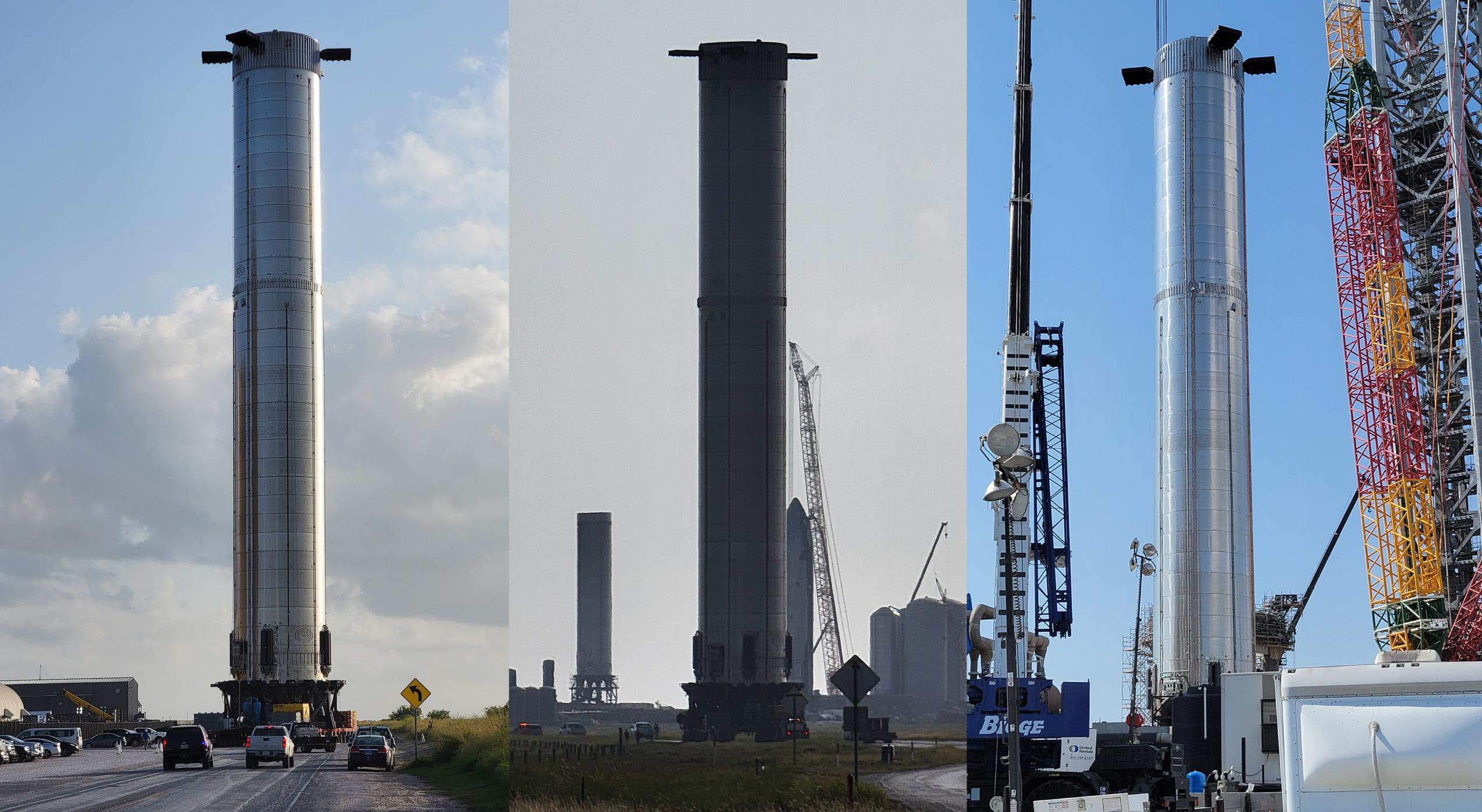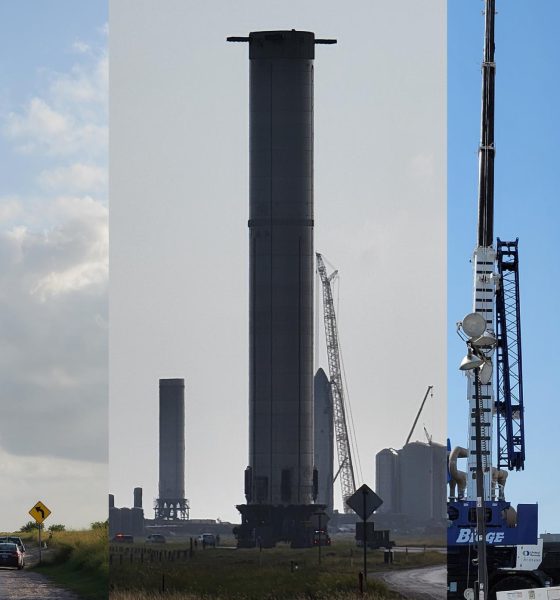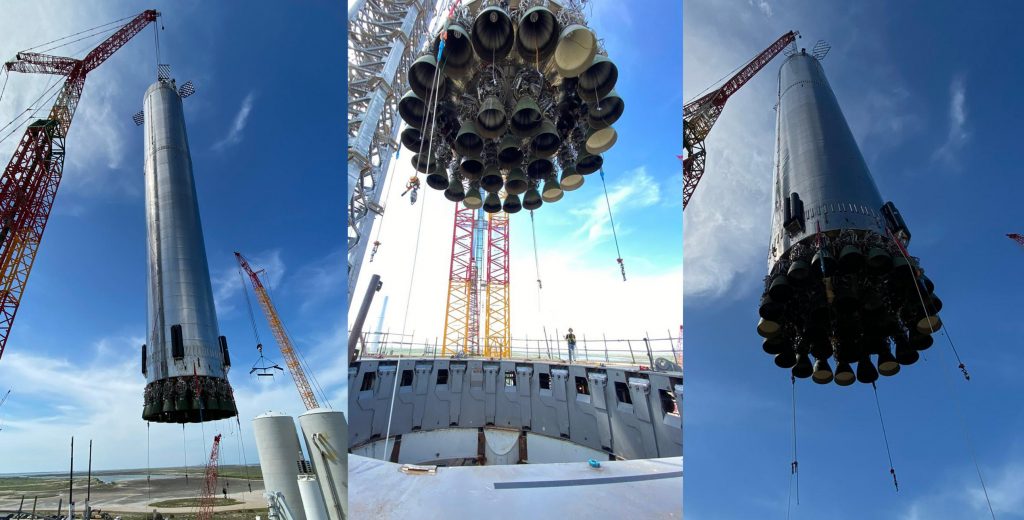

News
SpaceX’s first orbital-class Super Heavy booster rejoins Starship at the launch pad
For the second time in five weeks, SpaceX has rolled Starship’s first orbital-class Super Heavy booster from its Starbase factory to the launch pad ahead of a challenging and multifaceted test campaign.
Deemed Super Heavy Booster 4 or B4, the 69m (~225 ft) tall rocket first rolled to the launch pad around August 3rd after SpaceX technicians fitted it with 29 Raptor engines in a single night. Followed by orbital-class Starship prototype S20 a few days later, the two stages of a Starship were stacked to their full height on August 6th, briefly creating the largest rocket ever assembled. Ship 20 was then quickly returned to the build site, where SpaceX workers completed an additional ~10 days of finishing touches – mainly focused on avionics wiring and secondary plumbing.
A week later, Booster 4 followed Ship 20 back to Starbase’s ‘high bay,’ where teams ultimately removed all 29 of its Raptor engines and spent the next four or so weeks performing similar final integration work. Now, after installing what looks like hundreds of feet of wiring, dozens of additional gas and fluid lines, compressed gas tanks, hydraulic ‘sleds’ SpaceX’s first flightworthy Super Heavy has once again returned to the launch site
A bit less than two weeks ago, SpaceX once again installed 29 Raptors on Booster 4. This time around, though, all of those engines are believed to be ready for flight – or, at minimum, static fire testing – after completing qualification testing at SpaceX’s Central Texas development facilities. Intriguingly, every one of Super Heavy’s outer ring of 20 ‘Raptor Boost’ engines is also expected to have its own small umbilical panel that will connect to the orbital launch pad’s ground systems.
When Booster 4 was installed on the brand new orbital launch mount, most of those individual engine connectors had yet to be installed and it’s unclear if SpaceX was actually able to test the complex mechanisms before Super Heavy returned to the build site. This time, all 20 engine umbilical actuators have been installed on the launch mount and it’s safe to assume that those mechanisms will be tested extensively in the coming weeks.
That testing will be part of a much more involved test campaign. Namely, if SpaceX intends to test Super Heavy Booster 4 at the orbital launch site, any booster testing will simultaneously require the shakedown of the orbital pad’s extensive, custom-built tank farm and a wide range of other ground infrastructure that simply didn’t exist at the start of 2021. Booster 4 qualification is no less daunting, as no Super Heavy has ever been fully tested. Now in the midst of being scrapped in place at SpaceX’s suborbital test facilities, Super Heavy Booster 3 did complete a partial cryogenic proof test and a static fire with three Raptor engines, but SpaceX has never fully filled a Super Heavy with >3000 tons (~6.6M lb) of propellant and never static fired more than three Raptor engines simultaneously.

Perhaps the most uncertain part of Super Heavy Booster 4 qualification is its static fire test campaign. However SpaceX gets there, the final challenge will likely be igniting all 29 of B4’s Raptor engines – potentially producing up to ~5400 tons (11.9M lbf) of thrust, thus making Super Heavy the most powerful rocket booster ever tested.
Simultaneously, SpaceX also began reinstalling Raptors on Ship 20 – currently installed at Suborbital Pad B – ahead of the Starship’s first proof test(s) and static fire(s). Stay tuned for updates on SpaceX’s plans for testing the first orbital-class Starship and Super Heavy booster.

News
Nvidia CEO Jensen Huang explains difference between Tesla FSD and Alpamayo
“Tesla’s FSD stack is completely world-class,” the Nvidia CEO said.

NVIDIA CEO Jensen Huang has offered high praise for Tesla’s Full Self-Driving (FSD) system during a Q&A at CES 2026, calling it “world-class” and “state-of-the-art” in design, training, and performance.
More importantly, he also shared some insights about the key differences between FSD and Nvidia’s recently announced Alpamayo system.
Jensen Huang’s praise for Tesla FSD
Nvidia made headlines at CES following its announcement of Alpamayo, which uses artificial intelligence to accelerate the development of autonomous driving solutions. Due to its focus on AI, many started speculating that Alpamayo would be a direct rival to FSD. This was somewhat addressed by Elon Musk, who predicted that “they will find that it’s easy to get to 99% and then super hard to solve the long tail of the distribution.”
During his Q&A, Nvidia CEO Jensen Huang was asked about the difference between FSD and Alpamayo. His response was extensive:
“Tesla’s FSD stack is completely world-class. They’ve been working on it for quite some time. It’s world-class not only in the number of miles it’s accumulated, but in the way it’s designed, the way they do training, data collection, curation, synthetic data generation, and all of their simulation technologies.
“Of course, the latest generation is end-to-end Full Self-Driving—meaning it’s one large model trained end to end. And so… Elon’s AD system is, in every way, 100% state-of-the-art. I’m really quite impressed by the technology. I have it, and I drive it in our house, and it works incredibly well,” the Nvidia CEO said.
Nvidia’s platform approach vs Tesla’s integration
Huang also stated that Nvidia’s Alpamayo system was built around a fundamentally different philosophy from Tesla’s. Rather than developing self-driving cars itself, Nvidia supplies the full autonomous technology stack for other companies to use.
“Nvidia doesn’t build self-driving cars. We build the full stack so others can,” Huang said, explaining that Nvidia provides separate systems for training, simulation, and in-vehicle computing, all supported by shared software.
He added that customers can adopt as much or as little of the platform as they need, noting that Nvidia works across the industry, including with Tesla on training systems and companies like Waymo, XPeng, and Nuro on vehicle computing.
“So our system is really quite pervasive because we’re a technology platform provider. That’s the primary difference. There’s no question in our mind that, of the billion cars on the road today, in another 10 years’ time, hundreds of millions of them will have great autonomous capability. This is likely one of the largest, fastest-growing technology industries over the next decade.”
He also emphasized Nvidia’s open approach, saying the company open-sources its models and helps partners train their own systems. “We’re not a self-driving car company. We’re enabling the autonomous industry,” Huang said.
Elon Musk
Elon Musk confirms xAI’s purchase of five 380 MW natural gas turbines
The deal, which was confirmed by Musk on X, highlights xAI’s effort to aggressively scale its operations.

xAI, Elon Musk’s artificial intelligence startup, has purchased five additional 380 MW natural gas turbines from South Korea’s Doosan Enerbility to power its growing supercomputer clusters.
The deal, which was confirmed by Musk on X, highlights xAI’s effort to aggressively scale its operations.
xAI’s turbine deal details
News of xAI’s new turbines was shared on social media platform X, with user @SemiAnalysis_ stating that the turbines were produced by South Korea’s Doosan Enerbility. As noted in an Asian Business Daily report, Doosan Enerbility announced last October that it signed a contract to supply two 380 MW gas turbines for a major U.S. tech company. Doosan later noted in December that it secured an order for three more 380 MW gas turbines.
As per the X user, the gas turbines would power an additional 600,000+ GB200 NVL72 equivalent size cluster. This should make xAI’s facilities among the largest in the world. In a reply, Elon Musk confirmed that xAI did purchase the turbines. “True,” Musk wrote in a post on X.
xAI’s ambitions
Recent reports have indicated that xAI closed an upsized $20 billion Series E funding round, exceeding the initial $15 billion target to fuel rapid infrastructure scaling and AI product development. The funding, as per the AI startup, “will accelerate our world-leading infrastructure buildout, enable the rapid development and deployment of transformative AI products.”
The company also teased the rollout of its upcoming frontier AI model. “Looking ahead, Grok 5 is currently in training, and we are focused on launching innovative new consumer and enterprise products that harness the power of Grok, Colossus, and 𝕏 to transform how we live, work, and play,” xAI wrote in a post on its website.
Elon Musk
Elon Musk’s xAI closes upsized $20B Series E funding round
xAI announced the investment round in a post on its official website.

xAI has closed an upsized $20 billion Series E funding round, exceeding the initial $15 billion target to fuel rapid infrastructure scaling and AI product development.
xAI announced the investment round in a post on its official website.
A $20 billion Series E round
As noted by the artificial intelligence startup in its post, the Series E funding round attracted a diverse group of investors, including Valor Equity Partners, Stepstone Group, Fidelity Management & Research Company, Qatar Investment Authority, MGX, and Baron Capital Group, among others.
Strategic partners NVIDIA and Cisco Investments also continued support for building the world’s largest GPU clusters.
As xAI stated, “This financing will accelerate our world-leading infrastructure buildout, enable the rapid development and deployment of transformative AI products reaching billions of users, and fuel groundbreaking research advancing xAI’s core mission: Understanding the Universe.”
xAI’s core mission
Th Series E funding builds on xAI’s previous rounds, powering Grok advancements and massive compute expansions like the Memphis supercluster. The upsized demand reflects growing recognition of xAI’s potential in frontier AI.
xAI also highlighted several of its breakthroughs in 2025, from the buildout of Colossus I and II, which ended with over 1 million H100 GPU equivalents, and the rollout of the Grok 4 Series, Grok Voice, and Grok Imagine, among others. The company also confirmed that work is already underway to train the flagship large language model’s next iteration, Grok 5.
“Looking ahead, Grok 5 is currently in training, and we are focused on launching innovative new consumer and enterprise products that harness the power of Grok, Colossus, and 𝕏 to transform how we live, work, and play,” xAI wrote.








